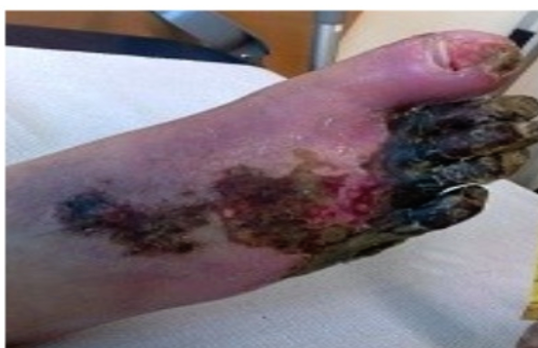Chronic Limb ischemia
Decreased limb perfusion for >2 weeks Senile atherosclerosis is common in both lower and upper limb
Etiology Lower limb ischemia:
- Atherosclerosis
- Thrombangitis obliterans
Upper Limb Ischemia:
- Aorto-arteritis (Takayasu arteritis)
- Raynaud’s disease
- Thoracic outlet obstruction
- Other rarer causes
- mixed cryoglobulinemia,
- nodular periarteritis,
- dermatomyositis,
- systemic scleroderma
Risk factors
- Old Age (>70 yrs)
- Male gender
- Diabetes
- Smoking
- Hypertension
- Hypercholesterolemia
- Hypertriglyceridemia
- Hyperhomocysteinemia
- Sedentary Lifestyle
- Family History
- Fatty diet
- Drugs (beta blockers, OCP)
Clinical presentation
- Pain (most common symptom) – on walking (Intermittent claudication / Rest pain
- Paraesthesia
- Pallor
- Diminished or absent pulse
- Cold limb (Poikilothermia)
- Diminished hair, brittle nail, thinning & shining of skin
- Small Ulcer
- Gangrene
Characteristic features of Claudication pain
-
- Always precipitated by activity
-
- Relieved by taking rest
-
- It is a cramp like pain felt over the muscles
-
- Is always reproducible.
Claudication Distance
- It is the distance travelled by a person with Peripheral Occlusive Vascular Disease before the onset of Pain.
- It is thought to be due to the accumulation of Substance P and Lactic acid.
Factors Affecting Claudication Distance Claudication Distance Decreases when-
- There is increased Speed of walking
- Resistance offered for walking
- Walking up hill
- Poor General Health & Systemic diseases of the patient


Z
 Intermittent claudications ⇒ Rest pain ⇒ Ischemic skin changes ⇒ gangrene Large part of limb
Intermittent claudications ⇒ Rest pain ⇒ Ischemic skin changes ⇒ gangrene Large part of limb
Rest Pain Rest Pain is the pain felt even at rest. It is due to the Ischemia of the somatic nerves(cry of the dying nerves)
- Felt in the foot (most distal parts)
- Exacerbate on lying down or elevation of foot
- Worse at night; patient sits in “hen-holding” position
- Pressure of even bed clothes worsens the pain
- Lessened by hanging the foot down or sleeping on a chair as the gravity aids in the blood flow to the nerves.
- Patient may commit suicide
